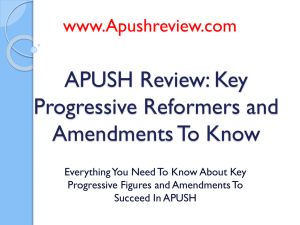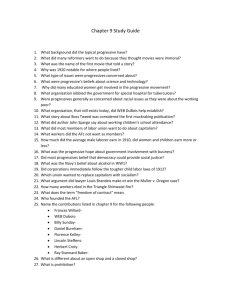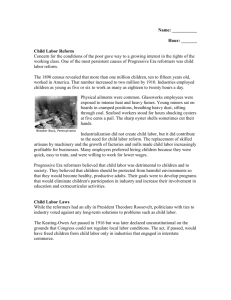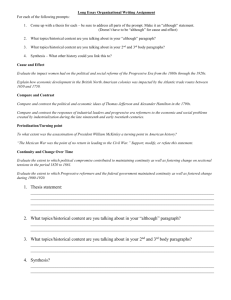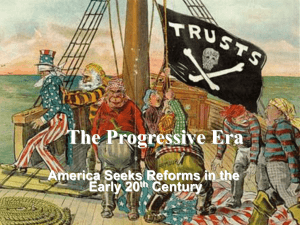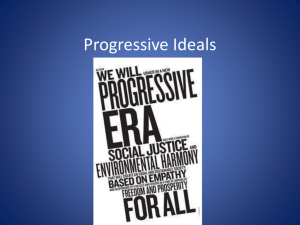1_Progressive_Era--U..
advertisement
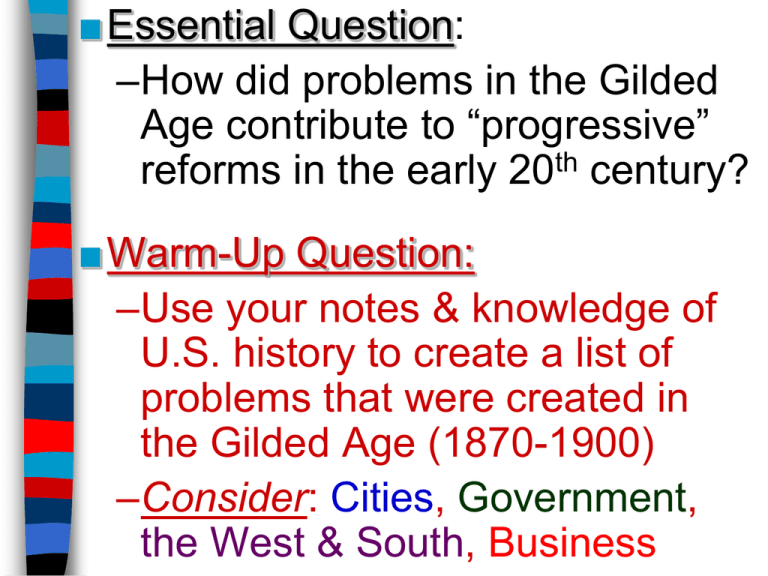
■Essential Question: –How did problems in the Gilded Age contribute to “progressive” reforms in the early 20th century? ■Warm-Up Question: –Use your notes & knowledge of U.S. history to create a list of problems that were created in the Gilded Age (1870-1900) –Consider: Cities, Government, the West & South, Business Urban Reform During the Progressive Era (1890-1920) ■From 1890 to 1920, reformers tried to clean up problems (“progress”) created during the Gilded Age: –Cities were plagued by slums, crime, disease, tenements –City, state, & national gov’ts were seen as corrupt & unresponsive to the needs of Americans –Corporate monopolies limited competition & workers’ wages The Social Gospel Movement ■In the 1880s, many middle-class Protestant Christians embraced the Social Gospel movement: –To honor God, people must put aside their own desires & help other people, especially the poor –These ideas helped inspire Progressive reform in U.S. cities Urban Progressive Reformers ■One of the earliest progressive reforms was the settlement house movement led by Jane Addams –Addams’ Hull House in Chicago offered baths, cheap food, child care, job training, health care to poor citizens in the slums –Her efforts inspired reformers in other cities to build settlement houses to assist the poor Urban Slums Jane Addams’ Hull House in Chicago Urban Progressive Reformers ■Urban reformers tried to improve the lives of poor workers & children –YMCA created libraries & gyms for young men & children –The Salvation Army created soup kitchens & nurseries –Florence Kelley fought to create child labor laws & laws limiting work hours for women Urban Progressive Reformers ■Many reformers saw alcohol abuse as serious urban problem: –Women’s Christian Temperance Union worked to end alcohol –Reformers gained prohibition laws in most states & outlawed alcohol throughout the USA with the 18th Amendment in 1919 –Hoped prohibition would end corruption, domestic violence, & help “Americanize” immigrants Carrie Nation Frances Willard Prohibition of alcohol in the states prior to 1920 Muckrakers ■In addition to the Social Gospel, progressive reformers were aided by a new, investigative journalism: –Muckrakers were journalists who exposed problems like poverty, corruption, monopolization (“Investigate, Educate, Legislate”) –Popular monthly magazines, like McClure’s & Colliers, used investigative journalism & photos What did Jacob Riis’ How the Other Half Lives (1890) expose? Jacob Riis’ How the Other Half Lives (1890) exposed urban poverty & life in the slums What did Ida Tarbell’s The History of Standard Oil (1904) expose? Ida Tarbell’s The History of Standard Oil (1904) revealed Rockefeller’s ruthless business practices & called for the break-up of large monopolies What did Upton Sinclair’s The Jungle (1906) expose? Upton Sinclair’s The Jungle (1906) revealed the unsanitary conditions of slaughterhouses & led to gov’t regulation of food industries Conclusions ■The Progressive movement began as an attempt to fix urban problems –Reformers lacked unity & were dedicated to their own causes –But their efforts led to a shift: gov’t began to take responsibility for citizens & intervene in their lives –Unlike the Populists, these reform efforts led to real change ■ Essential Question: –How did Progressive reformers attempt to improve the lives of women & African-Americans? ■ Warm-Up Question: –What was the “Social Gospel”? –What was a “muckraker”? –Who was the more important reformer: Florence Kelley, Jane Addams, Carrie Nation (WCTU)? The Women’s Movement ■ In the Gilded Age, women had more opportunities beyond marriage: –New urban jobs as secretaries, store clerks, & telephone operators gave a sense of independence –More girls graduated from high school & attended universities The Women’s Movement ■Women played an important role as Progressive reformers: –Jane Addams led the settlement house movement –Muckraker Ida Tarbell exposed monopoly abuses of Standard Oil –Florence Kelley helped bring about child & women labor laws –Carrie Nation & Frances Willard helped push for prohibition The Women’s Movement ■ Women reformers began to call attention to their own lack of rights: –In most states, married women could not divorce or own property Quick Class Discussion: –Women could not vote, but black, In what ways were women immigrant, & illiterate men could discriminated against or deprived –Women workers were paid less of the same rights given as men? than men for doing the same jobs –Middle & upper class women were expected to serve domestic & child rearing roles in the home Reform for Women ■Women reformers gained laws that banned prostitution & limited work hours for women to 10 hours ■Margaret Sanger promoted birth control for women: –Her journals provided contraceptive information for poor & middle-class women –Sanger opened the 1st birth control clinic in the U.S. in 1915 Women’s Suffrage (2.49) Women’s Suffrage ■The most significant reform for women was voting rights (suffrage) –Women demanded suffrage since Seneca Falls in 1848 –Were frustrated in 1870 when the 15th Amendment gave black men the right to vote but not women –In 1890, the National American Women Suffrage Association (NAWSA) was formed Suffragettes Women’s Suffrage ■NAWSA leaders Susan B. Anthony & Carrie Chapman Catt pressured states to let women vote & called for a national suffrage amendment –By the early 1900s, most western states allowed women to vote –Finally in 1920, the states ratified the 19th Amendment giving women to right to vote 19th Amendment: The right of the citizens of the United States to Women’s vote shall not be denied or abridgedSuffrage by the United States or by any Before State on account of sex. 1900 Reform for African-Americans Plessy v Ferguson (1896): were in ■ By 1900, African-Americans Segregation does not violate the need of progressive reform th 14 amendment & can be used as –80% lived infacilities rural areas in the long asofseparate are equal South, most asbut sharecroppers (“separate equal”) Quick Class Discussion: –Poll taxes & literacy tests limited In what ways were African-Americans black voting rights discriminated against or deprived of –Lynching violence common the same&rights givenwere as whites? –Plessy v Ferguson (1896) allowed Jim Crow laws to segregate in restaurants, hotels, schools African-American Reforms ■But, black leaders were divided on how to address racial problems –Booker T Washington was Harvard educated, The wisest among my race understand that urbanofculture, & wasis thestudied agitationblack of questions social equality the folly, that progress in the 1stextremist president ofand Tuskegee University enjoyment of all the privileges that will come to –His “Atlanta Compromise” stressed us must be the result of severe and constant black self-improvement & forcing struggle rather than of artificial T. Washington accommodation —Booker with whites African-American Reforms ■W.E.B. DuBois was more aggressive ■DuBois led the Niagara Movement in 1905 calling for immediate civil rights, We claim for ourselves every single right that belongs toschools, a free American, political, integrated & civil and social, and until we get these promotion of the “Talented 10th” rights we will never cease to protest to beand the next of black assail thegeneration ears of America civil rights leaders —W.E.B. DuBois The NAACP ■In 1909, reformers formed the National Association for the Advancement of Colored People (NAACP) to fight for black equality –DuBios was put in charge of The Crisis publication to call attention to the cause –The NAACP used lawsuits to fight segregation laws & voting restrictions Reforms for African-Americans ■Unlike women, African-Americans did not see significant changes: –Black reformers failed to convince state or national politicians to offer equality –By the end of the Progressive Era, segregation & lynching were common throughout the South & in many parts of the U.S. Closure Activity ■Examine excerpts of speeches by Washington & DuBois –What is the main idea of each? –In one sentence, summarize the approach of Washington & DuBois regarding civil rights –Whose approach was more appropriate for the early 20th century? Why?
